Dinesh Bharadia
Utilizing High Sampling Rate ADCs for Cost Efficient MIMO Radios
Mar 10, 2025Abstract:In the past decade, $>$1 Gsps ADCs have become commonplace and are used in many modern 5G base station chips. A major driving force behind this adoption is the benefits of digital up/down-conversion and improved digital filtering. Recent works have also advocated for utilizing this high sampling bandwidth to fit-in multiple MIMO streams, and reduce the number of ADCs required to build MIMO base-stations. This can potentially reduce the cost of Massive MIMO RUs, since ADCs are the most expensive electronics in the base-station radio chain. However, these recent works do not model the necessary decimation filters that exist in the signal path of these high sampling rate ADCs. We show in this short paper that because of the decimation filters, there can be introduction of cross-talks which can hinder the performance of these shared ADC interfaces. We simulate the shared ADC interface with Matlab 5G toolbox for uplink MIMO, and show that these cross-talks can be mitigated by performing MMSE equalization atop the PUSCH estimated channels.
PhaseMO: Future-Proof, Energy-efficient, Adaptive Massive MIMO
Jan 08, 2025



Abstract:The rapid proliferation of devices and increasing data traffic in cellular networks necessitate advanced solutions to meet these escalating demands. Massive MIMO (Multiple Input Multiple Output) technology offers a promising approach, significantly enhancing throughput, coverage, and spatial multi-plexing. Despite its advantages, massive MIMO systems often lack flexible software controls over hardware, limiting their ability to optimize operational expenditure (OpEx) by reducing power consumption while maintaining performance. Current software-controlled methods, such as antenna muting combined with digital beamforming and hybrid beamforming, have notable limitations. Antenna muting struggles to maintain throughput and coverage, while hybrid beamforming faces hardware constraints that restrict scalability and future-proofing. This work presents PhaseMO, a versatile approach that adapts to varying network loads. PhaseMO effectively reduces power consumption in low-load scenarios without sacrificing coverage and overcomes the hardware limitations of hybrid beamforming, offering a scalable and future-proof solution. We will show that PhaseMO can achieve up to 30% improvement in energy efficiency while avoiding about 10% coverage reduction and 5dB increase in UE transmit power.
Can We Remove the Ground? Obstacle-aware Point Cloud Compression for Remote Object Detection
Oct 01, 2024
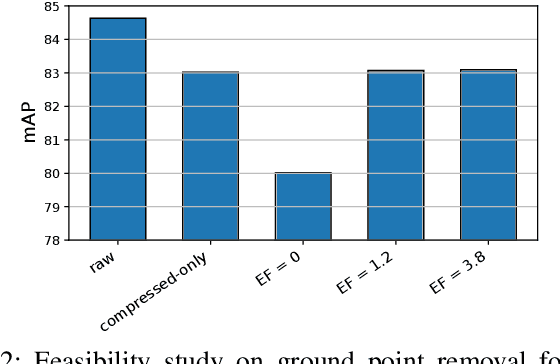
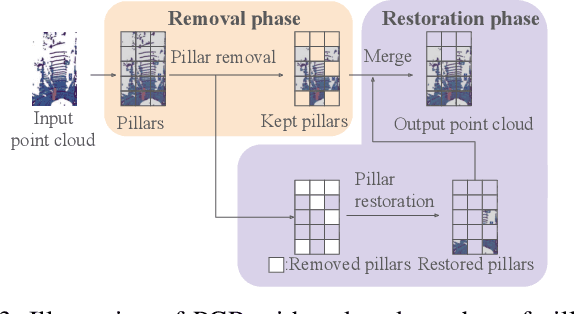
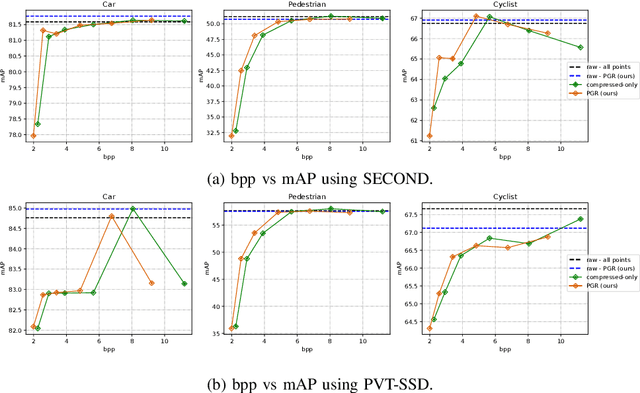
Abstract:Efficient point cloud (PC) compression is crucial for streaming applications, such as augmented reality and cooperative perception. Classic PC compression techniques encode all the points in a frame. Tailoring compression towards perception tasks at the receiver side, we ask the question, "Can we remove the ground points during transmission without sacrificing the detection performance?" Our study reveals a strong dependency on the ground from state-of-the-art (SOTA) 3D object detection models, especially on those points below and around the object. In this work, we propose a lightweight obstacle-aware Pillar-based Ground Removal (PGR) algorithm. PGR filters out ground points that do not provide context to object recognition, significantly improving compression ratio without sacrificing the receiver side perception performance. Not using heavy object detection or semantic segmentation models, PGR is light-weight, highly parallelizable, and effective. Our evaluations on KITTI and Waymo Open Dataset show that SOTA detection models work equally well with PGR removing 20-30% of the points, with a speeding of 86 FPS.
CalTag: Robust calibration of mmWave Radar and LiDAR using backscatter tags
Aug 29, 2024Abstract:The rise of automation in robotics necessitates the use of high-quality perception systems, often through the use of multiple sensors. A crucial aspect of a successfully deployed multi-sensor systems is the calibration with a known object typically named fiducial. In this work, we propose a novel fiducial system for millimeter wave radars, termed as \name. \name addresses the limitations of traditional corner reflector-based calibration methods in extremely cluttered environments. \name leverages millimeter wave backscatter technology to achieve more reliable calibration than corner reflectors, enhancing the overall performance of multi-sensor perception systems. We compare the performance in several real-world environments and show the improvement achieved by using \name as the radar fiducial over a corner reflector.
DOLOS: Tricking the Wi-Fi APs with Incorrect User Locations
Jul 23, 2024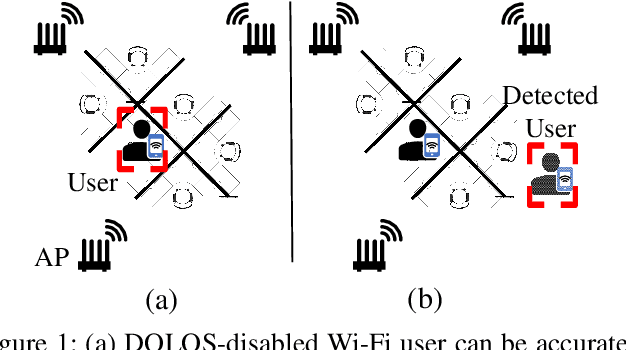
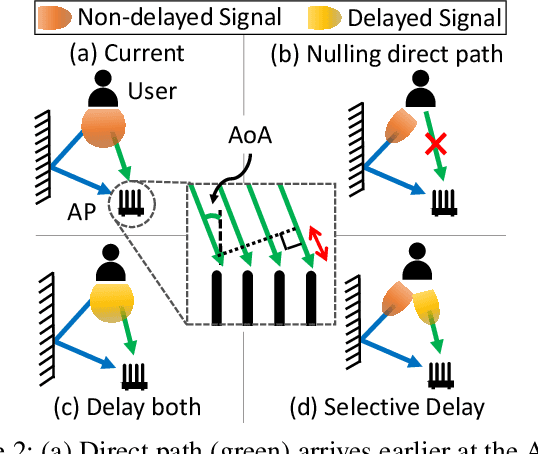
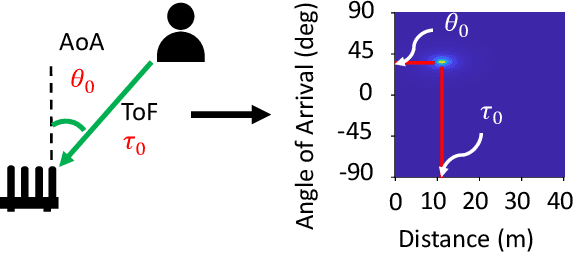

Abstract:Wi-Fi-based indoor localization has been extensively studied for context-aware services. As a result, the accurate Wi-Fi-based indoor localization introduces a great location privacy threat. However, the existing solutions for location privacy protection are hard to implement on current devices. They require extra hardware deployment in the environment or hardware modifications at the transmitter or receiver side. To this end, we propose DOLOS, a system that can protect the location privacy of the Wi-Fi user with a novel signal obfuscation approach. DOLOSis a software-only solution that can be deployed on existing protocol-compliant Wi-Fi user devices. We provide this obfuscation by invalidating a simple assumption made by most localization systems -- "direct path signal arrives earlier than all the reflections to distinguish this direct path prior to estimating the location". However, DOLOS creates a novel software fix that allows the user to transmit the signal wherein this direct path arrives later, creating ambiguity in the location estimates. Our experimental results demonstrate DOLOS can degrade the localization accuracy of state-of-art systems by 6x for a single AP and 2.5x for multiple AP scenarios, thereby protecting the Wi-Fi user's location privacy without compromising the Wi-Fi communication performance.
CommRad: Context-Aware Sensing-Driven Millimeter-Wave Networks
Jul 11, 2024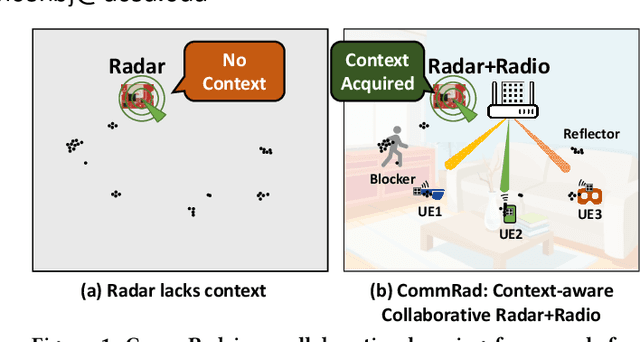
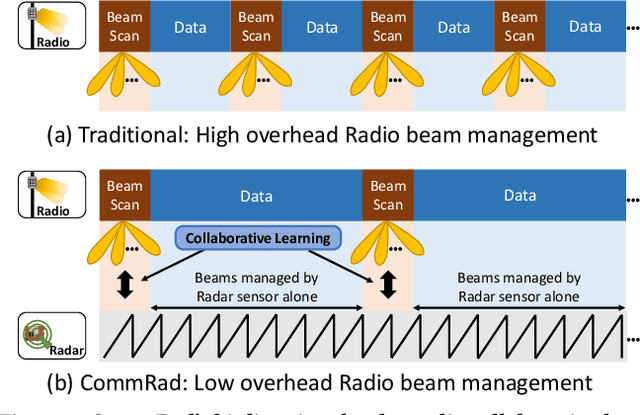
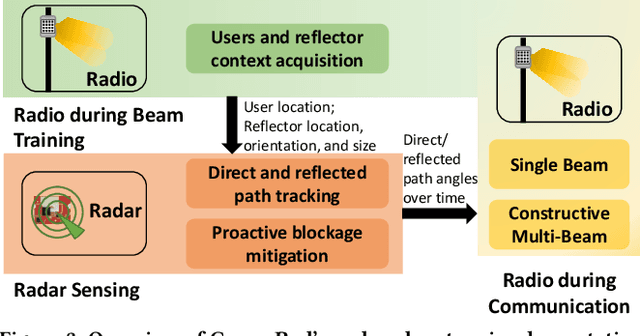
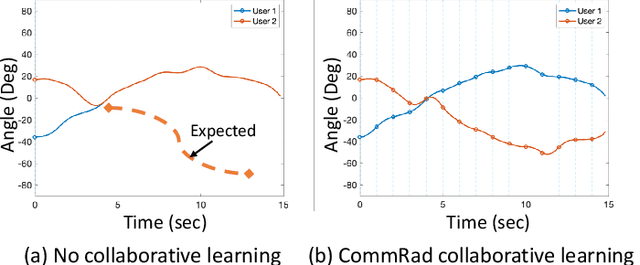
Abstract:Millimeter-wave (mmWave) technology is pivotal for next-generation wireless networks, enabling high-data-rate and low-latency applications such as autonomous vehicles and XR streaming. However, maintaining directional mmWave links in dynamic mobile environments is challenging due to mobility-induced disruptions and blockage. While effective, the current 5G NR beam training methods incur significant overhead and scalability issues in multi-user scenarios. To address this, we introduce CommRad, a sensing-driven solution incorporating a radar sensor at the base station to track mobile users and maintain directional beams even under blockages. While radar provides high-resolution object tracking, it suffers from a fundamental challenge of lack of context, i.e., it cannot discern which objects in the environment represent active users, reflectors, or blockers. To obtain this contextual awareness, CommRad unites wireless sensing capabilities of bi-static radio communication with the mono-static radar sensor, allowing radios to provide initial context to radar sensors. Subsequently, the radar aids in user tracking and sustains mobile links even in obstructed scenarios, resulting in robust and high-throughput directional connections for all mobile users at all times. We evaluate this collaborative radar-radio framework using a 28 GHz mmWave testbed integrated with a radar sensor in various indoor and outdoor scenarios, demonstrating a 2.5x improvement in median throughput compared to a non-collaborative baseline.
Densify & Conquer: Densified, smaller base-stations can conquer the increasing carbon footprint problem in nextG wireless
Mar 20, 2024



Abstract:Connectivity on-the-go has been one of the most impressive technological achievements in the 2010s decade. However, multiple studies show that this has come at an expense of increased carbon footprint, that also rivals the entire aviation sector's carbon footprint. The two major contributors of this increased footprint are (a) smartphone batteries which affect the embodied footprint and (b) base-stations that occupy ever-increasing energy footprint to provide the last mile wireless connectivity to smartphones. The root-cause of both these turn out to be the same, which is communicating over the last-mile lossy wireless medium. We show in this paper, titled DensQuer, how base-station densification, which is to replace a single larger base-station with multiple smaller ones, reduces the effect of the last-mile wireless, and in effect conquers both these adverse sources of increased carbon footprint. Backed by a open-source ray-tracing computation framework (Sionna), we show how a strategic densification strategy can minimize the number of required smaller base-stations to practically achievable numbers, which lead to about 3x power-savings in the base-station network. Also, DensQuer is able to also reduce the required deployment height of base-stations to as low as 15m, that makes the smaller cells easily deployable on trees/street poles instead of requiring a dedicated tower. Further, by utilizing newly introduced hardware power rails in Google Pixel 7a and above phones, we also show that this strategic densified network leads to reduction in mobile transmit power by 10-15 dB, leading to about 3x reduction in total cellular power consumption, and about 50% increase in smartphone battery life when it communicates data via the cellular network.
XRLoc: Accurate UWB Localization for XR Systems
Jul 24, 2023Abstract:Understanding the location of ultra-wideband (UWB) tag-attached objects and people in the real world is vital to enabling a smooth cyber-physical transition. However, most UWB localization systems today require multiple anchors in the environment, which can be very cumbersome to set up. In this work, we develop XRLoc, providing an accuracy of a few centimeters in many real-world scenarios. This paper will delineate the key ideas which allow us to overcome the fundamental restrictions that plague a single anchor point from localization of a device to within an error of a few centimeters. We deploy a VR chess game using everyday objects as a demo and find that our system achieves $2.4$ cm median accuracy and $5.3$ cm $90^\mathrm{th}$ percentile accuracy in dynamic scenarios, performing at least $8\times$ better than state-of-art localization systems. Additionally, we implement a MAC protocol to furnish these locations for over $10$ tags at update rates of $100$ Hz, with a localization latency of $\sim 1$ ms.
WiROS: WiFi sensing toolbox for robotics
May 22, 2023Abstract:Many recent works have explored using WiFi-based sensing to improve SLAM, robot manipulation, or exploration. Moreover, widespread availability makes WiFi the most advantageous RF signal to leverage. But WiFi sensors lack an accurate, tractable, and versatile toolbox, which hinders their widespread adoption with robot's sensor stacks. We develop WiROS to address this immediate need, furnishing many WiFi-related measurements as easy-to-consume ROS topics. Specifically, WiROS is a plug-and-play WiFi sensing toolbox providing access to coarse-grained WiFi signal strength (RSSI), fine-grained WiFi channel state information (CSI), and other MAC-layer information (device address, packet id's or frequency-channel information). Additionally, WiROS open-sources state-of-art algorithms to calibrate and process WiFi measurements to furnish accurate bearing information for received WiFi signals. The open-sourced repository is: https://github.com/ucsdwcsng/WiROS
Control and Placement of Finite-Resolution Intelligent Surfaces in IoT Systems with Imperfect CSI
Dec 16, 2022Abstract:In this paper, we study the advantages of using reconfigurable intelligent surfaces (RISs) for interference suppression in single-input single-output (SISO) distributed Internet of Things (IoT) networks. Implementing RIS-assisted networks confronts various problems, mostly related to the control and placement of the RIS. To tackle the control-related challenges, we consider noisy and local channel knowledge, based on which we devise algorithms to optimize the potentially distributed RISs to achieve an overall network objective, such as the sum-rate. We use a network with a centralized RIS as a benchmark for our comparisons. We further assume low-bit phase shifters at the RIS to capture real-world hardware limitations. We also study the placement of the RIS and analytically quantify the minimum required degrees-of-control for the RIS as a function of its location to guarantee a specific network performance metric and verify the results via simulations.
 Add to Chrome
Add to Chrome Add to Firefox
Add to Firefox Add to Edge
Add to Edge